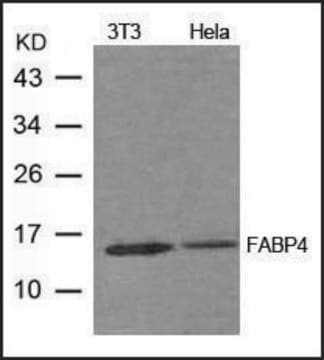AB5731
Anti-Nanog Antibody, NT
Chemicon®, from rabbit
Synonyme(s) :
Homeobox transcription factor Nanog, Nanog homeobox
About This Item
Produits recommandés
Source biologique
rabbit
Niveau de qualité
Forme d'anticorps
affinity purified immunoglobulin
Type de produit anticorps
primary antibodies
Clone
polyclonal
Produit purifié par
affinity chromatography
Espèces réactives
human, rat, mouse
Conditionnement
antibody small pack of 25 μg
Fabricant/nom de marque
Chemicon®
Technique(s)
western blot: suitable
Entrée
sample type: mouse embryonic stem cell(s)
sample type induced pluripotent stem cell(s)
sample type: human embryonic stem cell(s)
Isotype
IgG
Numéro d'accès NCBI
Numéro d'accès UniProt
Conditions d'expédition
ambient
Température de stockage
2-8°C
Modification post-traductionnelle de la cible
unmodified
Informations sur le gène
human ... NANOG(79923)
mouse ... Nanog(71950)
Description générale
NANOG may be useful in the immunohistochemical diagnosis of tumors. NANOG is expressed in germ cells of the fetus and in some germ cell tumors of the gonads and central nervous system (CNS).
Spécificité
Immunogène
Application
Stem Cell Research
Pluripotent & Early Differentiation
0.5-1.0 µg/mL. The antibody recognizes a protein of ~35 kDa on NT2/D1 cell lysate. Additional bands of ~55 and ~130 kDa may be seen depending on sample and antibody dilution used.Optimal working dilutions must be determined by the end user.
Qualité
Western Blot Analysis:
1:500 dilution of this lot detected NANOG on 10 μg of Embryonic Mouse Brain lysates
Description de la cible
Forme physique
Stockage et stabilité
Remarque sur l'analyse
Whole cell lysate from mouse embryonic stem cells.
Autres remarques
Informations légales
Clause de non-responsabilité
Not finding the right product?
Try our Outil de sélection de produits.
En option
Certificats d'analyse (COA)
Recherchez un Certificats d'analyse (COA) en saisissant le numéro de lot du produit. Les numéros de lot figurent sur l'étiquette du produit après les mots "Lot" ou "Batch".
Déjà en possession de ce produit ?
Retrouvez la documentation relative aux produits que vous avez récemment achetés dans la Bibliothèque de documents.
Notre équipe de scientifiques dispose d'une expérience dans tous les secteurs de la recherche, notamment en sciences de la vie, science des matériaux, synthèse chimique, chromatographie, analyse et dans de nombreux autres domaines..
Contacter notre Service technique








